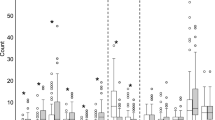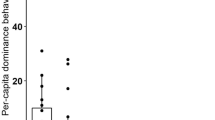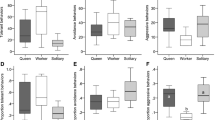Abstract
The first aim of this study was to investigate whether specific changes in the frequencies of behavioural characteristics are correlated with the cause or reflect the onset of the laying of haploid eggs by the queen, and whether these changes cause the onset of egg laying and aggressive behaviour by workers. The second aim was to obtain a better understanding of the occurrence of the behaviours in relation to the physiology and function of the queen and the workers.
No behavioural characteristics of workers which could predict the occurrence of the queen's switch to haploid egg laying was found nor did any such behaviour indicate that the switch had already occurred. The onset of worker oviposition was not found to be the consequence of the level or the type of agonistic actions between the workers and the queen.
With the onset of worker oviposition the agonistic behaviours called trembling and buzzing, which are directed at the queen, disappear. At the same time the frequency of a non-directed behaviour, called humming, increases. This behaviour is seen particularly in the small housebees with developed ovaries.
Before worker oviposition begins, the frequencies with which individual workers perform agonistic behaviour are not correlated with the conditions of their ovaries nor correlated with other characteristics of the workers. However, these frequencies are related to the sequence in which workers emerge. The correlations with age are due to the fact that workers of the first brood have higher activity levels than those of the later broods. The first egg layers are to be found among the first workers.
In the period of worker oviposition, humming and the aggressive behaviours of darting and attack are performed by workers with developed ovaries. These behaviours are directed particularly towards workers who also have active ovaries.
If the queen has disappeared 1 worker usually becomes dominant. This worker is characterized by the relatively high frequency with which she engages in darting and attacks. In addition, this worker is characterized by a specific behaviour, called pumping, which is directed at workers that have mature eggs in their ovaries. Behavioural domination, however, is no guarantee that the bee concerned will eventually become the most productive one.
Although at an apparently pre-determined moment in the ontogeny of the colony the queen loses control over worker oviposition and related behaviours, she remains dominant in various other behavioural hierarchies. It is therefore concluded that the queen never loses dominance completely.
Similar content being viewed by others
References
Blom, J. van der 1986 Reproductive dominance within colonies ofBombus terrestris (L.).Behaviour 97: 37–49.
Doorn, A. van & J. Heringa 1986 The ontogeny of a dominance hierarchy in colonies of the bumblebeeBombus terrestris (Hymenoptera, Apidae).Insectes Soc. 33: 3–25.
Doorn, A. van 1988 Reproductive dominance in bumblebees: an ethophysiological study.Thesis, University of Utrecht.The Netherlands.
Doorn, A. van 1989 Retinue behaviour in bumblebee (Bombus terrestris) workers.J. Apic. Res. (accepted).
Doorn, A. van 1989 Investigations into the regulation of dominance behaviour and of the division of labour in bumblebee colonies (Bombus terrestris).Neth. J. Zool. 37: 255–276.
Duchateau, M. J. & H. H. W. Velthuis 1988 Development and reproductive strategies inBombus terrestris colonies.Behaviour 107: 186–207.
Duchateau, M. J. & H. H. W. Velthuis 1989 Ovarain development and egg laying in workers ofBombus terrestris.Ent. exp. & appl. 51: 199–213.
Free, J. B. 1955 The behaviour of egg-laying workers of bumblebee colonies.Br. J. Anim. Beh. 3: 147–153.
Honk van C. G. J., H. H. W. Velthuis, P.-F. Röseler & M. E. Malotaux 1980 The mandibular glands ofBombus terrestris queens as a source of queen pheromones.Ent. exp. & appl. 28: 191–198.
Honk C. G. J., P.-F. Röseler, H. H. W. Velthuis & J. C. Hoogeveen 1981 Factors influencing the egg laying behaviour in a captiveBombus terrestris colony.Behav. Ecol. Sociobiol. 9: 9–14.
Honk van C. G. J. & P. Hogeweg 1981 The ontogeny of the social structure in a captiveBombus terrestris colony.Behav. Ecol. Sociobiol 9: 111–119.
Katayama, E. 1971 Observations on the brood development ofBombus ignitus (Hymenoptera, Apidae), 1. Egg-laying habits of queen and workers.Kontŷu 39: 189–203.
Pomeroy, N. & R. C. Plowright 1982 The relation between worker numbers and the production of males and queens in the bumblebeeBombus perplexus.Can J. Zool. 60: 954–957.
Röseler, P.-F. 1974 Grossenpolymorphismus, Geschlechtsregulation und Stabilisierung der Kasten im Hummelvolk. In: G. H. Schmidt (ed.)Sozialpolymorphismus. pp. 298–335. Wiss. Verlagsgesellschaft, Stuttgart.
Röseler, P.-F. & L. Röseler 1977 Dominance in bumblebees.Proc. 8th Int. Congr. IUSSI, Wageningen: 232–235. Pudoc: Wageningen.
Author information
Authors and Affiliations
About this article
Cite this article
Duchateau, M.J. Agonistic behaviours in colonies of the bumblebeeBombus terrestris . J. Ethol. 7, 141–151 (1989). https://doi.org/10.1007/BF02350036
Received:
Accepted:
Issue Date:
DOI: https://doi.org/10.1007/BF02350036




